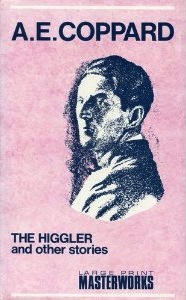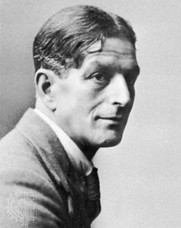
photo by Will Coles
Naming Names… in the Stories of A.E. Coppard
by Mike Smith
I’ve written before in this forum about the naming of stories, but now I’d like to take a closer look at the naming of characters – particularly in the short stories of A.E.Coppard.
Crotty Shinkwin is, I think, my favourite character name in all of Coppard, though Dunky Fitlow runs a close second. Reminding me of Stanley Unwin, with his not quite meaningless Unwinese, these two character names suggest meanings, or at least evoke responses, without letting you get a good hold on what those meanings might be.
Reminiscent of cruddy, but evocative of crottal, Crotty has the familiarity of a nickname like Knobby, or Dotty, but it leaves you wondering. And Shinkwin has the structure of well known names like Chegwin, or Schindler, but is less familiar than either of them. Dunky, on the other hand, is a verb, turned into a name by adding a ‘y’, and I’m sure I’ve met Fitlows, or at least imagined them.
 Names are important in Coppard’s work, as they should be in any story. Even writers who take names at random, from listings such as telephone directories, cannot avoid the implications and suggestions inherent in them. Coppard, we may be sure, chose his, or created them, with an eye to their sounds, and to their not-quite-meanings. Look at Mrs Sadgrove, from The Higgler, who thinks she is ‘not long for this world’, or at Beamish, from ‘A Wildgoose Chase’. What sort of Beam, I wonder, is he–’ish’? The obtuse sort that gets in your eye, or the wide grin that just might cover a lack of understanding?
Names are important in Coppard’s work, as they should be in any story. Even writers who take names at random, from listings such as telephone directories, cannot avoid the implications and suggestions inherent in them. Coppard, we may be sure, chose his, or created them, with an eye to their sounds, and to their not-quite-meanings. Look at Mrs Sadgrove, from The Higgler, who thinks she is ‘not long for this world’, or at Beamish, from ‘A Wildgoose Chase’. What sort of Beam, I wonder, is he–’ish’? The obtuse sort that gets in your eye, or the wide grin that just might cover a lack of understanding?
Some of the stories though, have a startling lack of names, or at least are careful of on whom they are bestowed. The man in ‘Arabesque–The Mouse’ is introduced without naming him, and is often referred to as ‘the man’ – even in scenes with Cassia and his mother, who use his name, Filip. The narrator uses his name once or twice, but returns to ‘the man’ thereafter, which allows us to stand back from him and witness his shame and discomfort without the inconvenience of him being someone to whom we have been formally introduced. We stand a little closer, I think, to Cassia, because of the continual use of her name, and because she is introduced into the story by use of it: ‘one fair recollection stirs in the man’s mind – of Cassia’.
Consider also ‘The Higgler’. Not so much a name as a label, but one which Mrs Sadgrove uses to address him: “Take the lot, higgler?” As with the previous example, it’s not just a matter of naming them, but one of referring to the characters. How does the narrator address them? How do the other characters address them, think of them? How are we to think of them?
In fact, the title of the story has already introduced Harvey Whitlow to us as The Higgler, and the opening lines reinforce that order of priorities: ‘ON A COLD APRIL AFTERNOON A HIGGLER WAS driving across Shag Moor in a two-wheeled cart.’ Only after this do we get his name, and that as a sign ‘painted on the hood’. Harvey, if I may call him that, is above all, a higgler – a man who must strike deals to survive – and this story is about a man failing to strike the right deals, and suffering for it.
A Harvey Whitlow is neither a Crotty Shinkwin, nor a Dunky Fitlow, and just thinking about that, about the way swapping around the names of Coppard characters would alter our perceptions of them, tells us how important they are to our perceptions of their stories. If Crotty Shinkwin had been The Higgler, would the story have worked so well? I don’t think I would have trusted him as much. And if he had been a Dunky Fitlow, I’m not sure I would have taken him so seriously. A Fitlow is not a Whitlow, no more than a Dunky is a Harvey.
Crotty Shinkwin is a character whose story is as fantastical as his name. He sets out on a fishing trip in his small boat, from the town of Ballinarailin. He’s an eponymous hero, and under his name the story begins: ‘This was a little man I’m telling you, Crotty Shinkwin, a butcher once, with livery eyes and a neck like a hen that was not often shaved’. The grammatical error, I’m thinking, leading to the ambiguity, is intentional.
 Coppard goes on to tell us a bit about the town. He tells us the names of its families – ‘a town full of Looneys, Mooneys and Clooneys, the Mahoneys, Maloneys, the Dorans, Horans and Morans’ – and if we haven’t got the idea by now that this is an idiomatically Irish comic story, that’s our lookout. Crotty is married to Eva Clohesy, and has friends called Tarpy Ryan, and J.P. The story involves an anchor snagged, and the island of Inniskalogue upended, and if you want any more you must read it for yourself.
Coppard goes on to tell us a bit about the town. He tells us the names of its families – ‘a town full of Looneys, Mooneys and Clooneys, the Mahoneys, Maloneys, the Dorans, Horans and Morans’ – and if we haven’t got the idea by now that this is an idiomatically Irish comic story, that’s our lookout. Crotty is married to Eva Clohesy, and has friends called Tarpy Ryan, and J.P. The story involves an anchor snagged, and the island of Inniskalogue upended, and if you want any more you must read it for yourself.
Crotty’s story is in the 1935 collection called Dunky Fitlow, who must therefore be regarded as being doubly eponymous. Dunky’s tale begins: ‘One fine day I told this tale to a stranger, and he turned up his nose’. But Dunky’s name doesn’t appear, except as the title, until the top of the second page, when the preamble ends and the storyteller begins in earnest: “Dunky Fitlow’s the name”. His is the only name in this story, save for the storyteller mentioning that he is going to the fair at ‘Asnamorig’ – which reinforces the Irish lilt in the telling. The story is almost wholly about Dunky and his wife, who is always referred to as ‘the camel faced woman’, and once again the issue is raised of how, and why a character is addressed, and by whom?
There are odd names throughout Coppard, names of both people and places. The names, along with the references that serve the function of names elsewhere, are all ways of labelling the characters and their contexts – and this is done, not so much to give them an air of credibility, as to manipulate our responses to them.

